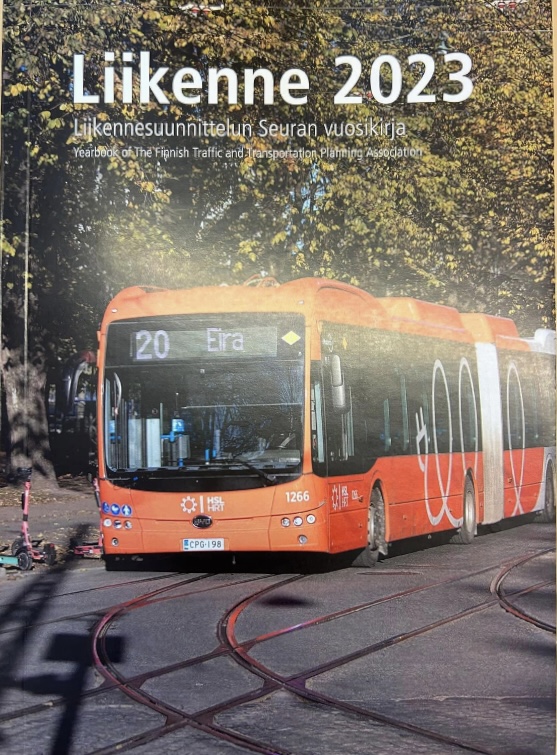Analysis of multimodal passenger terminal design and its effects on transfer penalty
DOI:
https://doi.org/10.58956/liikenne.142995Avainsanat:
.Abstrakti
With public transit systems becoming more and more sophisticated, the likelihood of passengers having to transfer between modes or lines increases. Transferring burdens, the passenger with added mental and physical effort, referred to as transfer penalty, which has a negative effect on the travel experience. The physical design of multimodal transfer terminals, such as train stations, can have a significant effect on transfer penalties but has received relatively little attention in practice. The aim of this review essay is to create an understanding of the ways in which the physical design of terminals can influence the transfer penalties experienced by passengers. Our findings show that terminal design can influence transfer penalties through actual and perceived walking and waiting times at transfer as well as the pure transfer penalty. We identified distinct categories of design elements and of other parts of the transit systems that urban designers can employ in influencing these aspects.
Lähdeviitteet
Allard, R. F., & Moura, F. (2016). The incorporation of passenger connectivity and intermodal considerations in intercity transport planning. Transport Reviews, 36(2), 251–277. https://doi.org/10.1080/01441647.2015.1059379
Cascajo, R., Garcia-Martinez, A., & Monzon, A. (2017). Stated preference survey for estimating passenger transfer penalties: Design and application to Madrid. European Transport Research Review, 9(3), 1–11. https://doi.org/10.1007/s12544-017-0260-x
Cascajo, R., Lopez, E., Herrero, F., & Monzon, A. (2019). User perception of transfers in multimodal urban trips: A qualitative study. International Journal of Sustainable Transportation, 13(6), 393–406. https://doi.org/10.1080/15568318.2018.1476632
Duca, G., Trincone, B., Bagamanova, M., Meincke, P., Russo, R., & Sangermano, V. (2022). Passenger dimensions in sustainable multimodal mobility services. Sustainability, 14(19), 12254. https://doi.org/10.3390/su141912254
Guo, Z., & Wilson, N. H. M. (2011). Assessing the cost of transfer inconvenience in public transport systems: A case study of the London Underground. Transportation Research. Part A, Policy and Practice, 45(2), 91–104. https://doi.org/10.1016/j.tra.2010.11.002
Iseki, H., & Taylor, B. D. (2009). Not all transfers are created equal: Towards a framework relating transfer connectivity to travel behaviour. Transport Reviews, 29(6), 777–800. https://doi.org/10.1080/01441640902811304
Iseki, H., & Taylor, B. D. (2010). Style versus service? An analysis of user perceptions of transit stops and stations. Journal of Public Transportation,13(3),23-48.https://doi.org/10.5038/23750901.13.3.2
Kalakou, S., & Moura, F. (2014). Bridging the gap in planning indoor pedestrian facilities. Transport Reviews, 34(4), 474–500. http://dx.doi.org/10.1080/01441647.2014.915441
Li, H., Xu, J., Zhang, X., & Ma, F. (2021). How do subway signs affect pedestrians’ wayfinding behaviour through visual short-term memory? Sustainability, 13(12), 6866.
https://doi.org/10.3390/su13126866
Liu, R., Pendyala, R. M., & Polzin, S. (1997). Assessment of intermodal transfer penalties using stated preference data. Transportation Research Record, 1607(1), 74–80.
https://doi.org/10.3141/1607-11
Lois, D., Monzón, A., & Hernández, S. (2018). Analysis of satisfaction factors at urban transport interchanges: Measuring travellers’ attitudes to information, security and waiting. Transport Policy, 67, 49–56. https://doi.org/10.1016/j.tranpol.2017.04.004
Molyneaux, N., Scarinci, R., & Bierlaire, M. (2021). Design and analysis of control strategies for pedestrian flows. Transportation, 48(4), 1767–1807. https://doi.org/10.1007/s11116-020-10111-1
Raveau, S., Guo, Z., Muñoz, J. C., & Wilson, N. H. M. (2014). A behavioural comparison of route choice on metro networks: Time, transfers, crowding, topology and socio-demographics.
Transportation Research. Part A, Policy and Practice, 66, 185–195. http://dx.doi.org/10.1016/j.tra.2014.05.010
Tiedostolataukset
Julkaistu
Numero
Osasto
Lisenssi
Copyright (c) 2024 Iina Rusanen, Florian Wiest

Tämä työ on lisensoitu Creative Commons Nimeä-EiKaupallinen-EiMuutoksia 4.0 Kansainvälinen Julkinen -lisenssillä.



